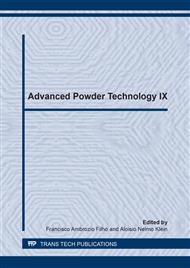p.51
p.56
p.61
p.66
p.72
p.78
p.84
p.90
p.96
Study of Electrical, Mechanical and Microstructural Properties of Composites Based on Cu-Ni-Ag-Al2O3 Obtained by Powder Metallurgy
Abstract:
The synthesis, microstructural, electrical and mechanical properties characterization of composites based on Cu-Ni–Ag-Al2O3 is a work that exposes the investigation of the correlation of the microstructures formed in the material with its physical properties and its manufacturing method. Cermets based on copper, nickel and silver have been doped with alumina varying the proportions of these components to create, by powder metallurgy, a material that has good electrical conductivity and good mechanical strength compared with that of pure copper, together with a manufacturing process which is both cost and energy efficient. The conductivity values vary between 30 to 55% IACS showing that the thermal treatments were effective for electrical connector uses.
Info:
Periodical:
Pages:
72-77
Citation:
Online since:
December 2014
Price:
Сopyright:
© 2014 Trans Tech Publications Ltd. All Rights Reserved
Share:
Citation:


